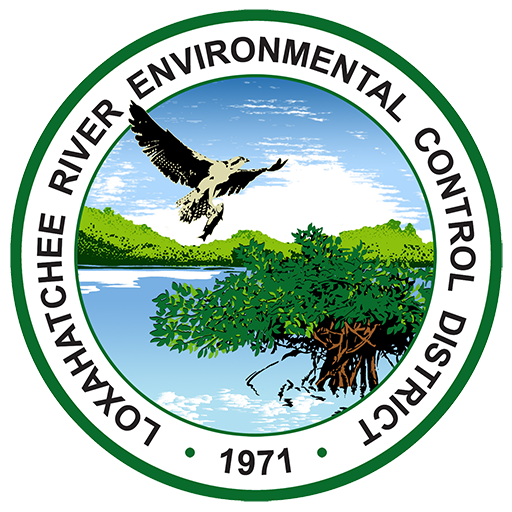Extensive water quality monitoring by the Loxahatchee River District, in partnership with the Town of Jupiter and the Florida Department of Environmental Protection, has shown consistently high fecal indicator bacteria (FIB) levels in Jones Creek canals. These bacteria are commonly found in the guts of humans and animals (dogs, racoons, and even wading birds), but they are also common in natural habitats, like mangrove swamps and in decaying vegetation. In Jones Creek bacteria (enterococci) concentrations are often far above (20 to 80x) the Environmental Protection Agency’s (EPA’s) recommended Beach Action Value (BAV) of 71 MPN/100mL for recreational waters. This is a concern because these tidal mangrove creeks are utilized by the public for recreation (e.g., boating, kayaking, paddle boarding and fishing).
The best available information suggests the high bacteria levels in Jones Creek are, in large part, the result the extensive organic-rich sediments, leaf litter and vegetation debris in the poorly flushed, choked waterway. Other factors may include animal excrement (predominantly dogs, racoons, and wading birds) entering the waterway, and other natural causes. Despite all properties in the basin served by central sewer (i.e. no septic systems), molecular analysis of water quality samples in 2019 and 2020 also indicated very low concentrations of human sewage, possibly a single household, and we are working to identify the likely source(s).
The Department of Health advises against consuming fish or swimming in waters with high bacteria counts. We urge residents to pick up dog waste and never dump pollutants or refuse, including grass clippings, fish or other carcasses, into natural waterways, canals, or storm drains.
The Loxahatchee River District, Town of Jupiter and Florida Department of Environmental Protection are working to better understand the issue, and help develop sensible solutions. For more information, please see the links below.
Interactive Water Quality Maps
Town of Jupiter Vegetation Trimming Project – Water Quality Response Report 2025
- Final Report (7MB PDF)
Nano Bubble Ozone Technology (NBOT) Water Quality Improvement Study (Summer & Fall 2021)
- Final Report (2MB PDF)
- Nano Bubble Ozone Technology (NBOT) Project in Jones Creek – Fact Sheet (0.5MB PDF)
- Kickoff webinar meeting July 14, 2021 – Presentation Slides (2MB PDF)
- This project is funded in large part by the State of Florida through the Florida Department of Environmental Protection’s Innovative Technology Water Quality Improvement Grant
- See the Protecting Florida Together website
NBOT Water Quality Data Explorer
- Click on the double arrows on the lower right of graphics window to view full screen
- Data refreshed at 6pm and 10am; However, there may be delays of up to an hour for the new visuals due to website processing.
NBOT Water Quality Data from Instrumentation
- Data recorded every 15 minutes
- Instrument data downloaded every other week; Calibration checks weekly
- No Turbidity or Chlorophyll sensors on Sims Creek instrument
Water Quality Instrumentation Data
For additional information, please see:
• U.S. Environmental Protection Agency (EPA) Microbial/Recreational Water Quality Criteria
• Florida Department of Health – Florida Healthy Beaches Program
• Town of Jupiter’s
• Loxahatchee River District’s
- Jones Creek Fecal Indicator Bacteria, Genetic Markers, Chemical Indicators, and Turbidity 2019-2021 Study Summary by LRD and DEP
- Jones Creek Fecal Indicator Bacteria and Turbidity Monitoring – Preliminary Findings Summary, December 2019
- Jones Creek Water Quality Investigation Update April 2019
- Jones Creek Presentation to the LRD Governing Board August 2017
- Jones Creek Septic Tank / Water Quality Investigation 1995
- Jones Creek Historical Aerial Photos
- Weekly Bacteria Testing Results
- RiverKeeper Water Quality Monitoring Program
Please contact us at (561) 401-4037 or email: info@lrecd.org if you have any questions.
